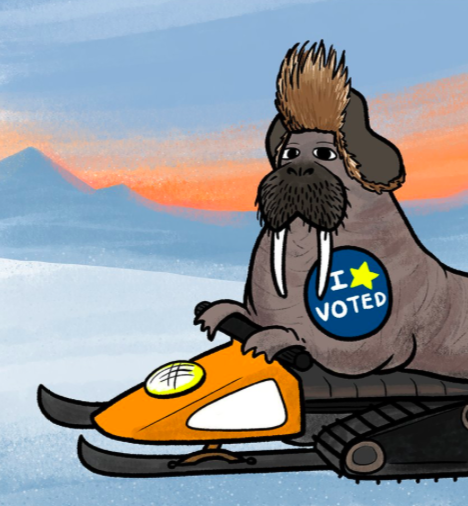TURNOUT MODERATE
Two weeks after the Nov. 6 General Election in Alaska, enough of the absentee votes are counted that we can take a look at turnout.
Statewide, turnout was 49 percent, a strong number considering that the Division of Elections has a massive 571,851 registered voters for this election cycle — the most in Alaska history.
That means over 77 percent of the entire Alaska population is now eligible to vote.
Some 184,000 Alaskans are under the age of 18 and therefore ineligible to vote. These numbers are according to the U.S. Census and are, by nature, inexact.
280,458 of the 571,851 eligible ended up casting ballots before 8 pm on Nov. 6.
The voter rolls have ballooned in the decade since 2008, when there were only 495,000 registered voters.
An anomaly is that although the overall population of the state has increased by 7.28 percent in those 10 years, the registered voters have increased by 15 percent.
The biggest jump came between 2016 and 2018, when the number of registered voters jumped nearly 8 percent. At the same time, applicants for the Permanent Fund dividend dropped by 2,118 by the March 31 deadline this year, an indicator of a falling population. Actual population dropped by 2,629, according to the State of Alaska.
How can the population drop and yet Alaska has more registered voters than at any time in the history of the state? Chalk it up to automatic voter registration during the Permanent Fund dividend application process.
668,588 applied for a Permanent Fund dividend. Anyone who was eligible to register was automatically enrolled as a voter. The opt-out provision was badly managed.
IMPACT OF BALLOT MEASURE 1
Ballot initiatives are used to drive voter turnout, but Ballot Measure 1 underperformed for the Democrats who pushed it.
Ballot Measure 1 would have made salmon protections more stringent than current laws provide. Millions of dollars were spent by both the environmental lobby and the business community to motivate people to vote either yes or no on what became known as the “Stand for Salmon” or “Stand for Alaska” ballot question.
Ballot Measure 1 earned fewer total votes than the other two statewide items on the ballot, which were the governor’s race with 278,597 votes and the congressional race with 277,647 votes.
Yet for all the millions spent on persuasion, Ballot Measure 1 only brought 271,168 votes. Several thousand voters either were undecided or found the dense language on the ballot confusing and put-offish.
Generally, higher voter turnout favors Democrats. But in this election, Republicans took the Congressional race, the Governor’s Office, the State House and the State Senate. They also crushed Ballot Measure 1.
With Ballot Measure 1 failing by a landslide, 62.4 to 37.6 percent, it appears that a large number of Democrats and progressives — as much as 18 percent — voted against the measure that was placed on the ballot specifically to bring them out to the polls.
TOP DISTRICTS FOR TURNOUT
The most avid voters in the state were in House District 28, Rabbit Creek-South Anchorage, with a 62 percent turnout.
The lowest performing district in the state remains House District 15, JBER-Muldoon, where 28 percent of the voters turned out.
District 2 Fairbanks, where Rep. Steve Thompson is the incumbent, had only a 29 percent turnout — a poor showing that resulted in the defeat of incumbent Senator Pete Kelly.

Suzanne, Alaska’s population is getting “grayer.” Fewer “greys” leaving the state than before, thanks to climate change. And the “greys” vote.
Pete Kelly did not lose because of poor voter turnout in HD 2. He lost because 500-600 Republicans chose not to vote for him, even though they voted for the Republican House Candidates.
About 5,000 combined votes were cast in total for the Republican Candidates in HD1 and HD2. Pete Kelly got about 4,400. Almost 700 more votes went for Kawasaki than went combined to HD1 and HD2 Democrat Candidates.
Pete Kelly lost because he lost the confidence of Fairbanks voters that sent him to Juneau to bring about change in the State.
He shoulda been sending out birthday cards like Kawasaki does. That was the difference.
A Juneau friend had a really good point. She asked how much we all could have spent on salmon habitat improvements if both sides of the argument hadn’t spent it on bringing or defeating a politically motivated ballot initiative. That’s a lot of habitat restoration.